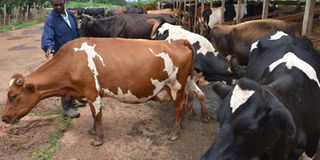Lameness in dairy cows

A farmer at the Bukura Agriculture Training College's dairy animals unit in Kakamega checks on the cattle they keep. Lameness in dairy cows can be a costly disease both in terms of money and cow welfare and is usually caused by lack of proper care and management of the cattle. FILE PHOTO | NMG
What you need to know:
- Lameness in dairy cows can be a costly disease both in terms of money and cow welfare.
- Feet disorders caused by infectious agents contribute to more than 70% of lameness.
- The resting period should last just longer than 1 hr as the cows’ use this time to ruminate and digest their feed.
- For dairy cows to have healthy claws, they should be allowed to exercise for some time each day so as to increase the amount of oxygen and nutrients that are delivered to the claw.
Lameness is the third most expensive health problem in dairy cows after reproduction and mastitis. A cow that develops lameness before breeding may have problems conceiving.
This is because a lame cow may not struggle for feed in a herd resulting in poor body condition. Research shows that in every 12 months, more than half the cows in a herd will experience lameness.
Lameness in dairy cows can be a costly disease both in terms of money and cow welfare. The costs include:
Premature culling rates (the biggest cost of lameness).
Treatment costs
Discarded milk after antibiotic use.
Decreased milk production.
Poor body condition
Poor reproductive performance
Lameness in dairy cattle falls into two broad categories: those caused by infectious agents and those caused by poor management.
Feet disorders caused by infectious agents contribute to more than 70% of lameness. Lesions that cause lameness induce intense pain to dairy cows making it a major animal welfare issue.
Claw infections contribute to 90% of lameness and are associated with the outer claws of the hindlimbs.
The most common cases of lameness include: whiteline disease, sole injuries, laminitis, digital dermatitis and footrot.
In many cases, lameness in dairy cattle occurs around calving time due to excessive wear of the sole, caused by increased weight of the cow, and in raining seasons when the sole is soft due to the dump environment.
There are several causes of lameness; they include:
Poor quality floors in cattle housing made of mud or sharp gravel
Cows’ forced to stand for long hours on hard floors
Poorly designed races that are too narrow for the herd size
Nutritional causes (cows fed on a high carbohydrate diet will develop ruminal acidosis which is a key factor leading to laminitis).
Ineffective hoof trimming and foot bathing
Cows’ dirty environment harboring infectious diseases
Stress caused by overstocking
Improper dairy housing that prevent the cows from resting
Breeding decisions focusing on productivity and ignoring feet and legs.
CONTROLLING LAMENESS
There are several ways that a farmer can prevent lameness in their dairy herd:
Cow comfort should be the primary focus to preventing claw lesions in dairy cows. The cow stalls should be of proper size to allow the cow to comfortably lie down, enter or exit the stall. A cow will normally lie down to rest 10-11 hours per day.
The resting period should last just longer than 1 hr as the cows’ use this time to ruminate and digest their feed.
Lameness will increase the lying time depending on the severity. Cow comfort will protect the cows from developing sole ulcers, whiteline disease among others.
The floor of the dairy corridors and milking parlors should be nonslip and not abrasive. The floor should be clean and dry and excessive manure removed. You may provide sand at the cows stall as it keeps the cows cool and provides good footage.
Mattresses made of rubber also provide the cows with a soft footing and a good place to lie down. A comfortable cow will produce more milk.
The hooves of cows should be trimmed once or twice a year to improve their comfort and performance.
A foot bath should be placed outside the milking parlor so that the cows dip their feet as they enter or leave the milking parlor. Copper sulfate or formalin can be used in the foot bath.
A good footbath should measure 3-3.7m long, 0.5-.06 m wide and 28cm deep to enable the cows be able to deep their hooves as they pass. Foot baths protect the cows from developing foot conditions like digital dermatitis
It is important that farmers practice a habit of observing the cows for signs of lameness as early detection and treatment will decrease the time to recovery.
For dairy cows to have healthy claws, they should be allowed to exercise for some time each day so as to increase the amount of oxygen and nutrients that are delivered to the claw.
Dairy cows should be supplemented with minerals as deficiency of zinc and some vitamins like biotin will lead to poor hoof development (soft horns, cracked hooves, abnormal hooves etc.).
Intromin mineral block should be fed free choice to dairy cows.
***
Dr John Muchibi is a Veterinary Surgeon and the Animal Health Manager at Elgon Kenya Ltd. Reach him through +254733715102 or e-mail him through [email protected]





